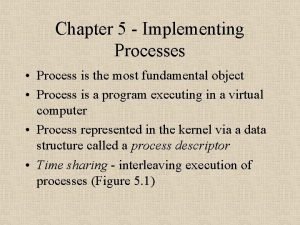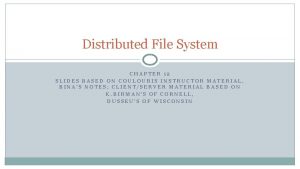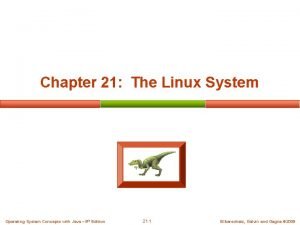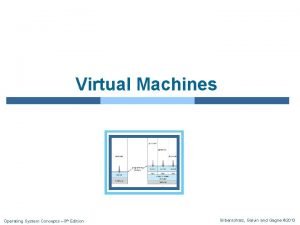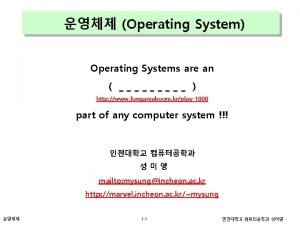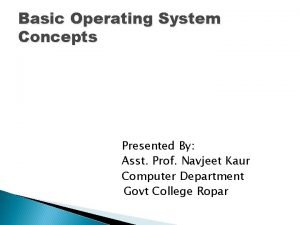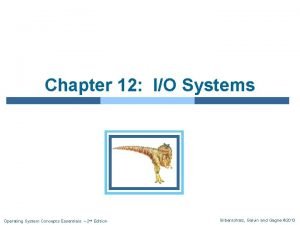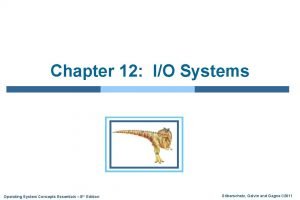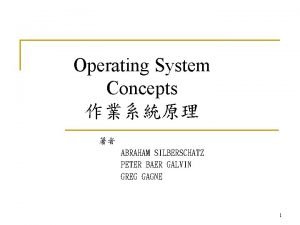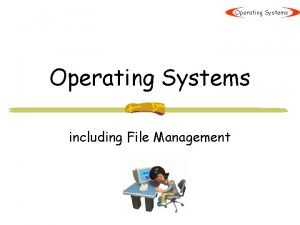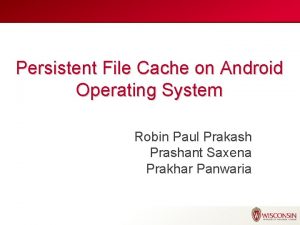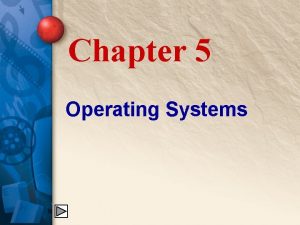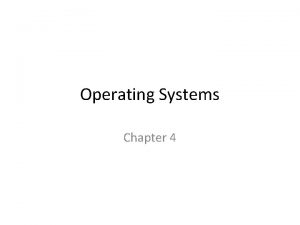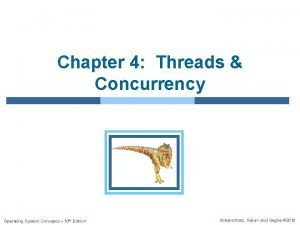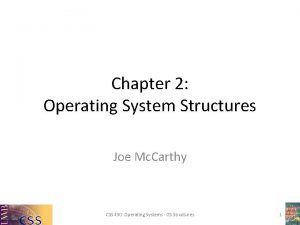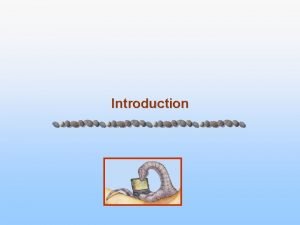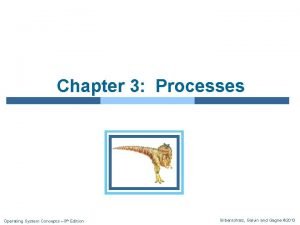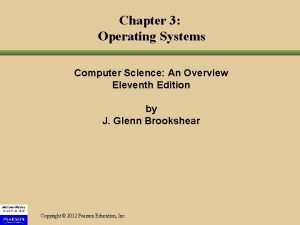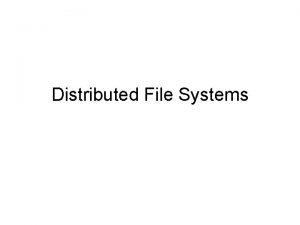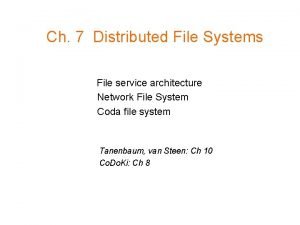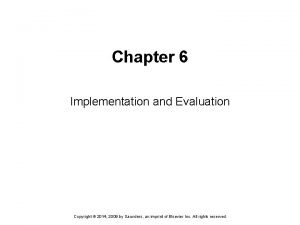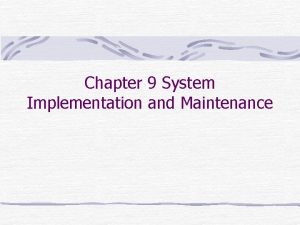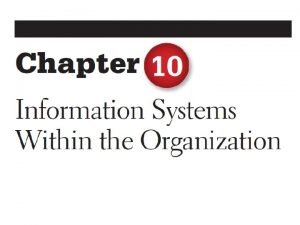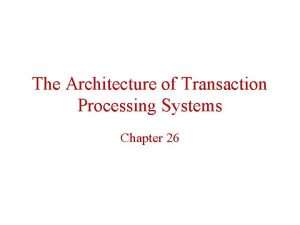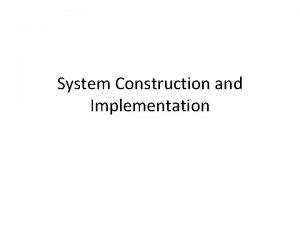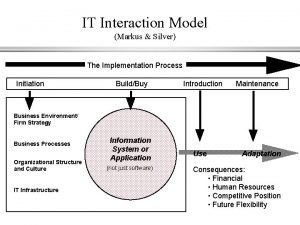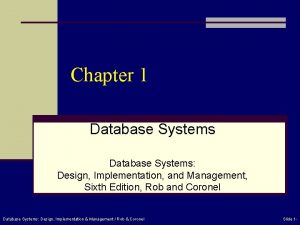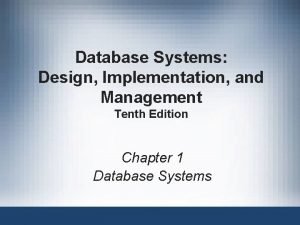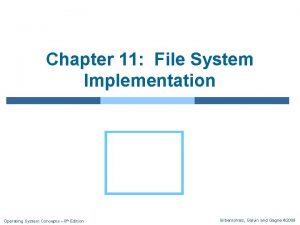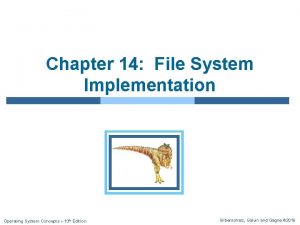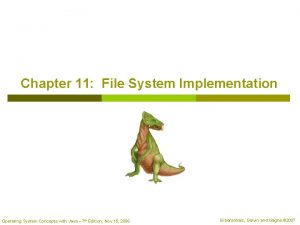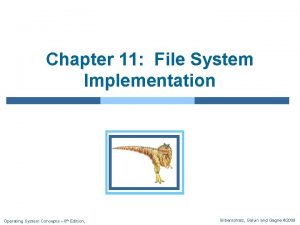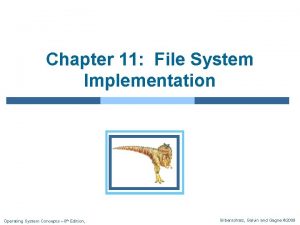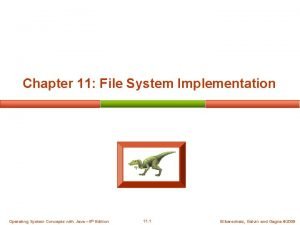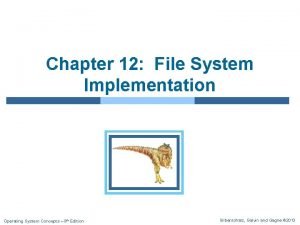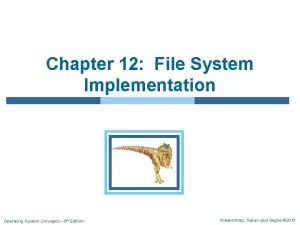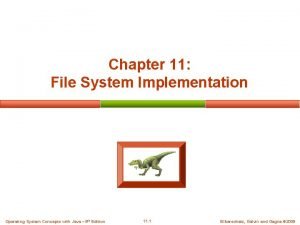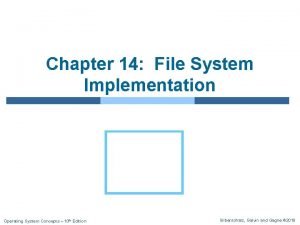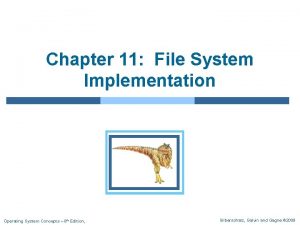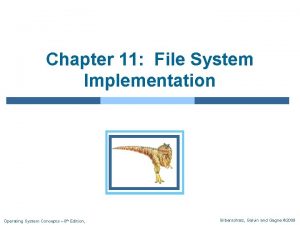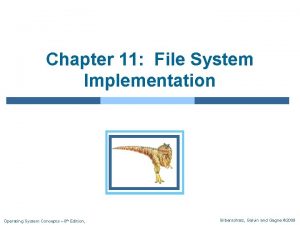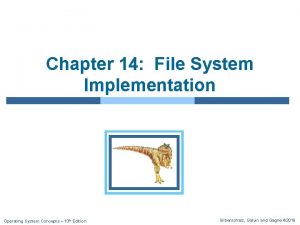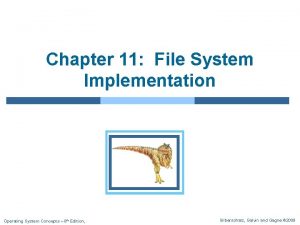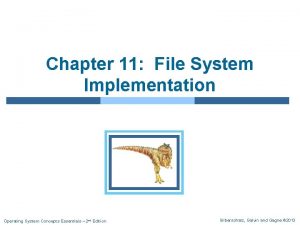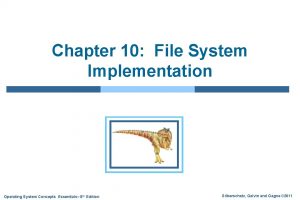Chapter 11 File System Implementation Operating System Concepts
























































- Slides: 56

Chapter 11: File System Implementation Operating System Concepts– 8 th Edition Silberschatz, Galvin and Gagne © 2009

Chapter 11: File System Implementation n File-System Structure n File-System Implementation n Directory Implementation n Allocation Methods n Free-Space Management n Efficiency and Performance n Recovery Operating System Concepts – 8 th Edition 11. 2 Silberschatz, Galvin and Gagne © 2009

Objectives n To describe the details of implementing local file systems and directory structures n To describe the implementation of remote file systems n To discuss block allocation and free-block algorithms and trade-offs Operating System Concepts – 8 th Edition 11. 3 Silberschatz, Galvin and Gagne © 2009

FILE-SYSTEM STRUCTURE Operating System Concepts – 8 th Edition 11. 4 Silberschatz, Galvin and Gagne © 2009

File-System Structure n File structure l Logical storage unit l Collection of related information n File system resides on secondary storage (disks) l Provides user interface to storage, mapping logical to physical l Provides efficient and convenient access to disk by allowing data to be stored, located, and retrieved easily n Disk provides in-place rewrite and random access l I/O transfers performed in blocks of sectors (usually 512 bytes) n File control block (FCB) – storage structure consisting of information about a file n Device driver controls the physical device n File system organized into layers Operating System Concepts – 8 th Edition 11. 5 Silberschatz, Galvin and Gagne © 2009

I/O Control Layer n Device drivers manage I/O devices at the I/O control layer l Transfers information between main memory and the disk l Translator: given commands like “read drive 1, cylinder 72, track 2, sector 10, into memory location 1060” outputs low-level hardware specific commands to hardware controller Operating System Concepts – 8 th Edition 11. 6 Silberschatz, Galvin and Gagne © 2009

Basic File System Layer n Basic file system given command like “retrieve block 123” translates to device driver l Also manages memory buffers and caches (allocation, freeing, replacement) l Buffers hold data in transit l Caches hold frequently used data l Also known as physical I/O layer Operating System Concepts – 8 th Edition 11. 7 Silberschatz, Galvin and Gagne © 2009

File Organization Module Layer n File organization module understands files, logical address, and physical blocks l Translates logical block # to physical block # l Manages free space, disk allocation Operating System Concepts – 8 th Edition 11. 8 Silberschatz, Galvin and Gagne © 2009

Logical File System Layer n Logical file system manages metadata information l Translates file name into file number, file handle, location by maintaining file control blocks (inodes in Unix) l Directory management l Protection Operating System Concepts – 8 th Edition 11. 9 Silberschatz, Galvin and Gagne © 2009

File System Layers (Cont. ) n Layering useful for reducing complexity and redundancy, but adds overhead and can decrease performance n Logical layers can be implemented by any coding method according to OS designer n Many file systems, sometimes many within an operating system l Each with its own format (CD-ROM is ISO 9660; Unix has UFS, FFS; Windows has FAT, FAT 32, NTFS as well as floppy, CD, DVD Blu-ray, Linux has more than 40 types, with extended file system ext 2 and ext 3 leading; plus distributed file systems, etc. ) n New ones still arriving: ZFS, Google. FS, Oracle ASM, FUSE Operating System Concepts – 8 th Edition 11. 10 Silberschatz, Galvin and Gagne © 2009

FILE-SYSTEM IMPLEMENTATION Operating System Concepts – 8 th Edition 11. 11 Silberschatz, Galvin and Gagne © 2009

File-System Implementation n We have system calls at the API level, but how do we implement their functions? l On-disk structures 4 Boot control block 4 Volume control block 4 Directory 4 File l structure Control Block (FCB) In-memory structures 4 Mount table 4 Directory-structure 4 System-wide 4 Per-process cache open-file table 4 Buffers Operating System Concepts – 8 th Edition 11. 12 Silberschatz, Galvin and Gagne © 2009

On-Disk File System Structures n Boot control block contains info needed by the system to boot OS (if present) from that volume l Usually first block of volume n Volume control block contains volume details l Total # blocks, # free blocks, block size, free block pointers or array l UFS: superblock l NTFS: master file table n Directory structure organizes the files l UFS: Names and inode numbers l NTFS: part of master file table n Per-file File Control Block (FCB) contains many details about the file l UFS: Inode number, permissions, size, dates l NTFS: part of master file table Operating System Concepts – 8 th Edition 11. 13 Silberschatz, Galvin and Gagne © 2009

A Typical File Control Block Operating System Concepts – 8 th Edition 11. 14 Silberschatz, Galvin and Gagne © 2009

In-Memory File System Structures n Mount table contains information about each mounted volume n Directory-structure cache (recently accessed directories) n System-wide open-file table l FCB for each open file n Per-process open-file table l Pointers to system-wide table n Buffers l Hold data blocks from secondary storage Operating System Concepts – 8 th Edition 11. 15 Silberschatz, Galvin and Gagne © 2009

Creating A File n Application calls logical file system n Logical file system l Knows format of directory structure l Allocates FCB n System updates directory structure n open() returns a file handle for subsequent use Operating System Concepts – 8 th Edition 11. 16 Silberschatz, Galvin and Gagne © 2009

open() & read() (cache) Operating System Concepts – 8 th Edition 11. 17 Silberschatz, Galvin and Gagne © 2009

Partitions and Mounting n Partition can be a volume containing a file system (“cooked”) or raw (just a sequence of blocks with no file system) n Boot block can point to boot volume or boot loader set of blocks that contain enough code to know how to load the kernel from the file system l Or a boot management program for multi-OS booting n Root partition contains the OS, other partitions can hold other OSs, other file systems, or be raw l Mounted at boot time l Other partitions can mount automatically or manually n At mount time, file system consistency checked l Is all metadata correct? 4 If not, fix it, try again 4 If yes, add to mount table, allow access Operating System Concepts – 8 th Edition 11. 18 Silberschatz, Galvin and Gagne © 2009

Virtual File Systems n Virtual File Systems (VFS) on Unix provide an object-oriented way of implementing file systems l Alternative is to write directory and file routines for each file system n VFS allows the same system call interface (the API) to be used for different types of file systems l Separates file-system generic operations from implementation details l Implementation can be one of many file systems types, or network file system 4 Implements l vnodes which hold inodes or network file details Then dispatches operation to appropriate file system implementation routines n The API is to the VFS interface, rather than any specific type of file system Operating System Concepts – 8 th Edition 11. 19 Silberschatz, Galvin and Gagne © 2009

Schematic View of Virtual File System Operating System Concepts – 8 th Edition 11. 20 Silberschatz, Galvin and Gagne © 2009

Virtual File System Implementation n For example, Linux has four object types: l inode: represents a file l file: represents an open file l superblock: represents an entire file system l dentry: represents a directory entry n VFS defines set of operations on the objects that must be implemented l Every object has a pointer to a function table 4 Function table has addresses of routines to implement that function on that object Operating System Concepts – 8 th Edition 11. 21 Silberschatz, Galvin and Gagne © 2009

DIRECTORY IMPLEMENTATION Operating System Concepts – 8 th Edition 11. 22 Silberschatz, Galvin and Gagne © 2009

Directory Implementation 1. Linear list of file names with pointer to the data blocks l Simple to program l Time-consuming to execute 4 Linear search time 4 Could keep ordered alphabetically via linked list or use B+ tree 2. Hash Table – linear list with hash data structure l Decreases directory search time l Collisions – situations where two file names hash to the same location l Only good if entries are fixed size, or use chained-overflow method Operating System Concepts – 8 th Edition 11. 23 Silberschatz, Galvin and Gagne © 2009

ALLOCATION METHODS Operating System Concepts – 8 th Edition 11. 24 Silberschatz, Galvin and Gagne © 2009

Allocation Methods n An allocation method refers to how disk blocks are allocated for files l Contiguous allocation l Linked allocation l Indexed allocation n Performance considerations: l Sequential access l Direct access l Fragmentation l Other Operating System Concepts – 8 th Edition 11. 25 Silberschatz, Galvin and Gagne © 2009

Allocation Methods - Contiguous n Contiguous allocation – each file occupies a set of contiguous blocks Operating System Concepts – 8 th Edition 11. 26 l Pros? l Cons? Silberschatz, Galvin and Gagne © 2009

Allocation Methods - Contiguous n Contiguous allocation l Best performance in most cases l Simple – only starting location (block #) and length (number of blocks) are required l Problems include: 4 Finding 4 File space for file size at allocation time 4 External 4 Need fragmentation for compaction Operating System Concepts – 8 th Edition 11. 27 Silberschatz, Galvin and Gagne © 2009

Extent-Based Systems n Many newer file systems (i. e. , Veritas File System) use a modified contiguous allocation scheme n Extent-based file systems allocate disk blocks in extents n An extent is a contiguous block of disks l Extents are allocated for file allocation l A file consists of one or more extents Operating System Concepts – 8 th Edition 11. 28 Silberschatz, Galvin and Gagne © 2009

Allocation Methods - Linked n Linked allocation – each file is a linked list of blocks Operating System Concepts – 8 th Edition 11. 29 l Each block contains pointer to next block l File ends at null pointer Silberschatz, Galvin and Gagne © 2009

Allocation Methods - Linked n Linked allocation l No external fragmentation l Free space management system called when new block needed l Improve efficiency by clustering blocks into groups but increases internal fragmentation l Reliability can be a problem l Locating a block can take many I/Os and disk seeks n FAT (File Allocation Table) variation l Beginning of volume has table, indexed by block number l Much like a linked list, but faster on disk and cacheable l New block allocation simple Operating System Concepts – 8 th Edition 11. 30 Silberschatz, Galvin and Gagne © 2009

File-Allocation Table Operating System Concepts – 8 th Edition 11. 31 Silberschatz, Galvin and Gagne © 2009

Allocation Methods - Indexed n Indexed allocation l Operating System Concepts – 8 th Edition Each file has its own index block(s) of pointers to its data blocks 11. 32 Silberschatz, Galvin and Gagne © 2009

Allocation Methods - Indexed n Need index table n Random access n Dynamic access without external fragmentation, but have overhead of index block n What’s the maximum file size? l Block size / address size * block size l Linked scheme – Link blocks of index table (no limit on size) Operating System Concepts – 8 th Edition 11. 33 Silberschatz, Galvin and Gagne © 2009

Combined Scheme: UNIX UFS (4 K bytes per block, 32 -bit addresses) n How large of a file can be accessed with direct blocks? 12 * 4 KB = 48 KB n How large of a file can be accessed with single indirect? l (4 K/4) * 4 KB = 4 MB l (12) Operating System Concepts – 8 th Edition 11. 34 Silberschatz, Galvin and Gagne © 2009

Combined Scheme: UNIX UFS (4 K bytes per block, 32 -bit addresses) n How large of a file can be accessed with double indirect? (4 K/4)2 * 4 KB = 4 GB n How large of a file can be accessed with triple indirect? l (4 K/4)3 * 4 KB = 4 TB l (12) Operating System Concepts – 8 th Edition 11. 35 Silberschatz, Galvin and Gagne © 2009

Performance n Best method depends on file access type l Contiguous great for sequential and random n Linked is not good for random (but good for sequential) n Declare access type at creation -> select either contiguous or linked n Indexed more complex l Single block access could require 2 index block reads then data block read l Clustering can help improve throughput, reduce CPU overhead Operating System Concepts – 8 th Edition 11. 36 Silberschatz, Galvin and Gagne © 2009

Performance (Cont. ) n Adding instructions to the execution path to save one disk I/O is reasonable l Intel Core i 7 Extreme Edition 990 x (2011) at 3. 46 Ghz = 159, 000 MIPS 4 http: //en. wikipedia. org/wiki/Instructions_per_second l Typical disk drive at 250 I/Os per second 4 159, 000 l MIPS / 250 = 630 million instructions during one disk I/O Fast SSD drives provide 60, 000 I/Os per second 4 159, 000 MIPS / 60, 000 = 2. 65 millions instructions during one disk I/O Operating System Concepts – 8 th Edition 11. 37 Silberschatz, Galvin and Gagne © 2009

• Bit map • Linked list • Grouping • Counting • Space maps FREE-SPACE MANAGEMENT Operating System Concepts – 8 th Edition 11. 38 Silberschatz, Galvin and Gagne © 2009

Free-Space Management: Bit maps n File system maintains free-space list to track available blocks/clusters l (Using term “block” for simplicity) n Bit vector or bit map (n blocks) 0 1 2 n-1 ��� … bit[i] = 1 block[i] free 0 block[i] occupied CPUs have instructions to return offset within word of first “ 1” bit Operating System Concepts – 8 th Edition 11. 39 Silberschatz, Galvin and Gagne © 2009

Free-Space Management: Bit maps (Cont. ) n Bit map requires extra space l Example: block size = 4 KB = 212 bytes disk size = 240 bytes (1 terabyte) n = 240/212 = 228 bits (or 256 MB) if clusters of 4 blocks -> 64 MB of memory n Easy to get contiguous files Operating System Concepts – 8 th Edition 11. 40 Silberschatz, Galvin and Gagne © 2009

Linked Free Space List on Disk n Linked list (free list) l l l Each free block has the address of the next free block Location of the first entry kept in a special location Cannot get contiguous space easily No wasted space No need to traverse the entire list (if # free blocks recorded) FAT: Records free block info Operating System Concepts – 8 th Edition 11. 41 Silberschatz, Galvin and Gagne © 2009

Free-Space Management (Cont. ) n Grouping Linked list of blocks that are full of addresses of free blocks l Last entry is the address of the next “index” block l Less I/Os n Counting l Because space is frequently contiguously used and freed, with contiguous-allocation, extents, or clustering l Modify linked list l In addition to next address, store number of free blocks l Larger records, but you need fewer of them l Operating System Concepts – 8 th Edition 11. 42 Silberschatz, Galvin and Gagne © 2009

Free-Space Management (Cont. ) n Space Maps l Used in ZFS Consider meta-data I/O on very large file systems 4 Full data structures like bit maps couldn’t fit in memory 4 Thousands of I/Os to read info l Divides device space into metaslab units and manages metaslabs l 4 Given volume can contain hundreds of metaslabs l Each metaslab has associated space map 4 Uses counting algorithm l But records to log file rather than file system 4 Log of all block activity, in time order, in counting format l Metaslab activity -> load space map into memory in balanced-tree structure, indexed by offset 4 Replay log into that structure 4 Combine contiguous free blocks into single entry Silberschatz, Galvin and Gagne © 2009 11. 43 Operating System Concepts – 8 th Edition

EFFICIENCY AND PERFORMANCE Operating System Concepts – 8 th Edition 11. 44 Silberschatz, Galvin and Gagne © 2009

Efficiency n Efficiency dependent on: l Disk allocation and directory algorithms l Types of data kept in file’s directory entry l Pre-allocation or as-needed allocation of metadata structures 4 E. g. l UNIX inodes are preallocated Fixed-size or varying-size data structures Operating System Concepts – 8 th Edition 11. 45 Silberschatz, Galvin and Gagne © 2009

Performance n Performance l Keeping data and metadata close together l Buffer cache – separate section of main memory for frequently used blocks l Synchronous writes sometimes requested by apps or needed by OS 4 No buffering / caching – writes must hit disk before acknowledgement 4 Asynchronous writes more common, buffer-able, faster l Reads frequently slower than writes (because of asynchronous writes) l Free-behind and read-ahead – techniques to optimize sequential access Operating System Concepts – 8 th Edition 11. 46 Silberschatz, Galvin and Gagne © 2009

I/O Without a Unified Buffer Cache n A page caches pages rather than disk blocks using virtual memory techniques and addresses l Memory-mapped I/O uses a page cache n Routine I/O through the file system uses the buffer (disk) cache Operating System Concepts – 8 th Edition 11. 47 Silberschatz, Galvin and Gagne © 2009

I/O Using a Unified Buffer Cache n A unified buffer cache uses the same page cache to cache both memory-mapped pages and ordinary file system I/O l Avoids double caching l Some versions of UNIX and Linux n But which caches get priority, and what replacement algorithms to use? Operating System Concepts – 8 th Edition 11. 48 Silberschatz, Galvin and Gagne © 2009

RECOVERY Operating System Concepts – 8 th Edition 11. 49 Silberschatz, Galvin and Gagne © 2009

Recovery n Consistency checking – compares data in directory structure with data blocks on disk, and tries to fix inconsistencies l Can be slow and sometimes fails n Use system programs to back up data from disk to another storage device (magnetic tape, other magnetic disk, optical) n Recover lost file or disk by restoring data from backup n Backup example script: http: //www. cs. mtsu. edu/~hcarroll/3250/private/rsync. Backup. sh Operating System Concepts – 8 th Edition 11. 50 Silberschatz, Galvin and Gagne © 2009

Log Structured File Systems n Log structured (or journaling) file systems record each metadata update to the file system as a transaction n All transactions are written to a log l A transaction is considered committed once it is written to the log l Sometimes to a separate device or section of disk l However, the file system may not yet be updated n Log transactions are asynchronously written to the file system structures l When the file system structures are modified, the transaction is removed from the log n If the file system crashes, all remaining transactions in the log must still be performed n Faster recovery from crash, removes chance of inconsistency of metadata Operating System Concepts – 8 th Edition 11. 51 Silberschatz, Galvin and Gagne © 2009

Recap ① Give two reason why must the bit map for file allocation should be kept in secondary storage, rather than in main memory? ② Suppose that the pointer to the free-space list is lost. Can the system reconstruct the free-space list? Explain. ③ Consider a file system on a disk that has both logical and physical block sizes of 512 bytes. Assume that the information about each file is already in memory. How is the logical-to-physical address mapping accomplished for each of the three allocation strategies (contiguous, linked, and indexed)? (For the indexed allocation, assume that a file is always less than 512 blocks long. ) ④ Consider a file system that uses inodes to represent files. Disk blocks are 8 KB in size and a pointer to a disk block requires 4 bytes. This file system has 12 direct disk blocks, plus single, double, and triple indirect disk blocks. What is the maximum size of a file that can be stored in this file system? Operating System Concepts – 8 th Edition 11. 52 Silberschatz, Galvin and Gagne © 2009

Recap - Answers ① Give two reason why must the bit map for file allocation should be kept in secondary storage, rather than in main memory? l So that the free-space list would not be lost after a system crash l It may be too large to fit in main memory. ② Suppose that the pointer to the free-space list is lost. Can the system reconstruct the free-space list? Explain. l Must do “garbage collection”: search entire directory structure to determine which pages are already allocated to jobs. Those remaining unallocated pages could be relinked as the free-space list. Operating System Concepts – 8 th Edition 11. 53 Silberschatz, Galvin and Gagne © 2009

Recap - Answers ③ …logical and physical block sizes of 512 bytes … info … in memory. How is the logical-to-physical address mapping accomplished …? l Let Z be the starting file address (block number). l Contiguous 4 Divide logical address by 512; X = quotient Y = remainder 4 Physical l Linked 4 Divide 4 Phy. l block number: X + Z; Displacement into block: Y logical address by 508; X = quotient Y = remainder blk: Follow X links; Displacement: Y + 1 Indexed: 4 Divide 4 Phy. logical address by 512; X = quotient Y = remainder blk: Read index block, Xth location; Displacement: Y Operating System Concepts – 8 th Edition 11. 54 Silberschatz, Galvin and Gagne © 2009

Recap - Answers ④ Consider a file system that uses inodes to represent files. Disk blocks are 8 KB in size and a pointer to a disk block requires 4 bytes. This file system has 12 direct disk blocks, plus single, double, and triple indirect disk blocks. What is the maximum size of a file that can be stored in this file system? l Use all four address schemes: l Blocks addressable from 1 page: 8 KB/4 B = 211 l Direct: (12 * 8 KB) = 96 KB l Single: (211 * 8 KB) = 16 MB l Double: ((211)2 * 8 KB) = 32 GB l Triple: ((211)3 * 8 KB) = 64 TB l Max file size = sum Operating System Concepts – 8 th Edition 11. 55 Silberschatz, Galvin and Gagne © 2009

End of Chapter 11 Operating System Concepts– 8 th Edition Silberschatz, Galvin and Gagne © 2009
 File-file yang dibuat oleh user pada jenis file di linux
File-file yang dibuat oleh user pada jenis file di linux Operating system concepts chapter 8 solutions
Operating system concepts chapter 8 solutions Operating system concepts chapter 5 solutions
Operating system concepts chapter 5 solutions Operating system concepts chapter 5 solutions
Operating system concepts chapter 5 solutions File system in operating system
File system in operating system File system in operating system
File system in operating system File system in operating system
File system in operating system Implementation of process in operating system
Implementation of process in operating system Distributed file system implementation
Distributed file system implementation Operating system
Operating system Linux operating system concepts
Linux operating system concepts Operating system concepts with java
Operating system concepts with java Operating system concepts 6th edition
Operating system concepts 6th edition Type 0 hypervisor
Type 0 hypervisor Realtime operating system
Realtime operating system 교보 drm
교보 drm Basic operating system concepts
Basic operating system concepts Operating system concepts 11th
Operating system concepts 11th Operating system concepts essentials
Operating system concepts essentials Operating system concepts essentials
Operating system concepts essentials Silberschatz operating system concepts
Silberschatz operating system concepts File management in operating system
File management in operating system Android manifest persistent
Android manifest persistent File management components
File management components Distributed file system
Distributed file system In a file-oriented information system, a transaction file
In a file-oriented information system, a transaction file Operating systems concepts
Operating systems concepts Geography: realms, regions, and concepts (doc or html) file
Geography: realms, regions, and concepts (doc or html) file Module 4 operating systems and file management
Module 4 operating systems and file management Physical image vs logical image
Physical image vs logical image Fungsi sistem file
Fungsi sistem file What does a markup tag tells the web browser
What does a markup tag tells the web browser Types of nos
Types of nos Understanding operating systems
Understanding operating systems Chapter 4 operating system
Chapter 4 operating system Concurrency vs parallelism in os
Concurrency vs parallelism in os Operating system chapter 2
Operating system chapter 2 Operating system chapter 1
Operating system chapter 1 Operating system chapter 3
Operating system chapter 3 Operating system chapter 3
Operating system chapter 3 Buddy system in os
Buddy system in os File system modules in distributed system
File system modules in distributed system File system architecture in distributed system
File system architecture in distributed system Chapter 6 implementation and evaluation
Chapter 6 implementation and evaluation System implementation and maintenance
System implementation and maintenance System design implementation and operation
System design implementation and operation Objectives of transaction processing system
Objectives of transaction processing system A deployment descriptor describes *
A deployment descriptor describes * System construction phase
System construction phase System development life cycle implementation phase
System development life cycle implementation phase Cse132c
Cse132c Rpc implementation in distributed system
Rpc implementation in distributed system System implementation process under it interaction model
System implementation process under it interaction model Database systems: design, implementation, and management
Database systems: design, implementation, and management Nachiket acharya
Nachiket acharya State of the art contracting
State of the art contracting Database systems design implementation and management
Database systems design implementation and management







